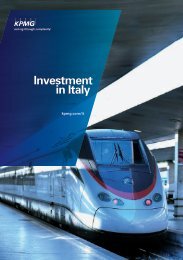Innovation Canada: A Call to Action
Innovation Canada: A Call to Action
Innovation Canada: A Call to Action
You also want an ePaper? Increase the reach of your titles
YUMPU automatically turns print PDFs into web optimized ePapers that Google loves.
Filling the GapsAngel InvestmentAt the earliest stage — perhaps even before acompany is formed — an entrepreneur typicallyrelies on informal sources of capital from“friends and family” and later from angelinves<strong>to</strong>rs. There are two structural obstacles thatlimit the supply of angel financing: (i) the veryhigh cost of evaluating and then moni<strong>to</strong>ring aprospect, relative <strong>to</strong> the size of the embryonicbusiness and (ii) the novelty and technologicalcomplexity of the new business idea, whichmakes it difficult for an outside inves<strong>to</strong>r <strong>to</strong>accurately determine the potential for success.As a result, angel inves<strong>to</strong>rs target a high rate ofreturn <strong>to</strong> compensate for the risk they face andoften require entrepreneurs <strong>to</strong> invest asubstantial fraction of their own wealth in theproject, both of which may prevent viableprojects from going forward. Knowledgeable andexperienced inves<strong>to</strong>rs are needed for capitalmarkets <strong>to</strong> function well, but there is also a rolefor government in promoting an efficient angelinvestment market segment.There are few reliable data on the supply–demand conditions in this informal market in<strong>Canada</strong>. In the US, where the market is welldeveloped, rates of return <strong>to</strong> angel inves<strong>to</strong>rgroups are high. A 2007 survey by the AngelCapital Education Foundation (now called theAngel Resource Institute) found that returns <strong>to</strong>angel inves<strong>to</strong>rs in groups averaged 27 percent(Wiltbank and Boeker 2007), which was wellabove the average 10-year return of 18.3 percen<strong>to</strong>n overall venture capital investments in 2007(National Venture Capital Association 2008).Industry participants describe the angelinvestment segment as underdeveloped in<strong>Canada</strong>, reflecting in part a relatively young riskcapital industry. As a result of this shortage ofsupply of financing relative <strong>to</strong> demand, it wouldbe expected that similar rates of return <strong>to</strong> thosein the US should be available <strong>to</strong> angel inves<strong>to</strong>rsin <strong>Canada</strong>.Venture Capital FinancingThose high-growth businesses that survive theseed and angel-financed stage of developmentusually then turn <strong>to</strong> the venture capital market,which is an important form of financing until thebusiness goes public, is bought out or is able <strong>to</strong>access conventional financing.The “modern” venture capital industry camein<strong>to</strong> being in the US in the late 1970s (Lerner2009). The Canadian venture capital industry, bycontrast, is relatively young and small, havinggotten a second start in the 1990s, just beforethe technology bubble burst. Venture capitalinvestment in <strong>Canada</strong> experienced a postbubblepeak of $2 billion in 2007; since then ithas averaged $1.2 billion a year (BDC 2011). In2010, about 350 companies in <strong>Canada</strong> receivedventure capital funding, with an averageinvestment of $3.2 million and a <strong>to</strong>talinvestment of $1.1 billion (CVCA 2011).Meanwhile, venture capital investment in the USin 2010, at $21.8 billion, was about 20 timesthe Canadian <strong>to</strong>tal, and the average deal sizewas about twice as large (SSTI 2011).The smaller relative scale of Canadian venturecapital funds has two main consequences. First,in order <strong>to</strong> create enough diversity in theirportfolios, fund managers must keep investmentper project relatively low. The small deal sizespreads fixed costs — for example, evaluationand moni<strong>to</strong>ring of investments — over a smallerinvestment base, which hurts returns. Second,smaller-scale Canadian funds are less able <strong>to</strong>participate in later-stage financing, since theseinvolve a larger average deal size. Canadianfunds therefore find it difficult <strong>to</strong> adopt thetypical US strategy of financing firms from early7-15
















